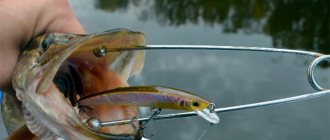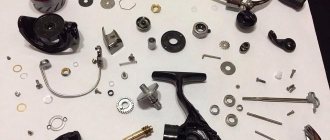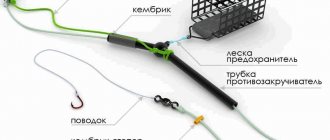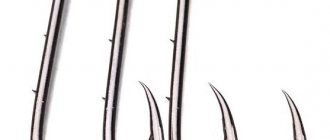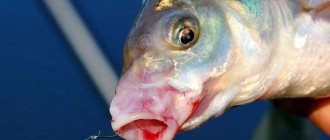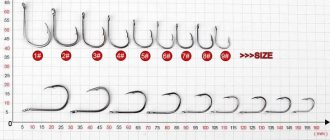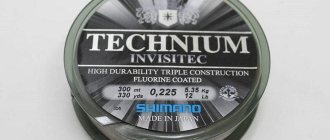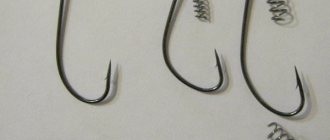Donka with a rubber shock absorber is very technologically advanced and often simply irreplaceable
tackle for fishing from the shore, especially since recently its use has again been permitted by the Rules of Amateur Fishing with a reservation only on the number of hooks. Now, with the beginning of the water rise in the rivers of the Volga-Akhtuba floodplain, fish spawning continues. The spring spawning ban is in effect until June 20. However, you can still fish from the shore, in the Astrakhan region even with a spinning rod with artificial bait. But what to do if the predator is not biting at all at the moment? Gear for white fish will help out: float rods and bottom gear.
So what are the advantages of bottom tackle with a rubber shock absorber?
The most important advantages are: - there is no noise caused by the sinker falling into the water when casting, which is very important when catching cautious fish, such as crucian carp, bream and carp; - the fish that takes the bait does not feel the resistance of the sinker; — there is no need to constantly re-cast the tackle after inspecting the bait or removing the fish from the hook; — the hooks always return to the same place, which makes bait or bait for fish in this patch especially effective, and in addition, bait in the form of dense balls can be delivered to the fishing spot directly using the same gear; — periodic movements of hooks along the bottom in one place create turbidity, which attracts fish to the fishing spot; — tackle with an elastic band has a significant advantage over other donks when catching predatory fish (pike, perch, bersh) with live bait. At the moment of casting a regular donkey, live bait, especially weak bait, often falls off the hook or is severely damaged and quickly dies. On bottoms with a rubber shock absorber, this does not happen when the line is carefully released; — it is possible to revive the bite by attracting fish by lightly moving the line, changing the tension of the rubber, changing and combining bait attachments.
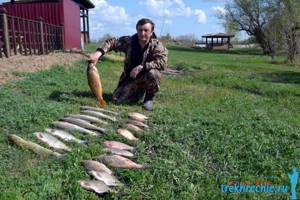
Donkeys with a rubber shock absorber also have disadvantages. They are as follows: - lack of maneuverability - the tackle is installed in one place and is difficult to move. This kind of fishing is more suitable for those who spend a long time in one place, for example at a campsite or with a tent on the shore of a reservoir; — not on every section of the coast it is possible to place gear comfortably enough: bushes, cliffs, strong currents, dense aquatic vegetation near the coastline make the use of a donkey with a rubber shock absorber impossible; — the rubber shock absorber is the “weak link” of the gear, since the rubber is easily damaged by sharp objects at the bottom (shells, stones), quickly ages from ultraviolet radiation and, as a result, can break at the most inopportune moment. You should always have a supply of rubber bands and weights with you; - a tightly stretched rubber shock absorber can pose a danger to the fisherman: if the extended tackle breaks, it can inadvertently injure the hooks, and if the rubber breaks, a strong blow occurs, which damages unprotected areas of the body (therefore, the hand pulling the elastic should be moved to the side). A properly assembled and installed bottom with a rubber shock absorber allows you to catch roach, herring, perch, sabrefish and many other types of Volga fish.
Pike fishing: how significant are the changes in 2020
Among experts and representatives of fishing organizations, it is noted that in general, the changes made to the Law “On Amateur Fishing” No. 475-FZ of December 25, 2018, adopted by the State Duma, are more general in nature. The document comes into force on 01/01/2020. Its norms concern a complete ban on fishing with nets, establishing daily limits on the volume of catch, etc. If we talk about such special cases as the spawning ban on pike, it will not change in 2021 with the entry into force of new norms.
It is necessary to analyze the general norms and prohibitions that were in force in sport fishing in our country in past years, and have not changed this year.
Bottom tackle device with rubber shock absorber
A special feature of the design of such a donkey is that between the very heavy end sinker and the line (a fragment of the tackle on which the leashes with hooks are located) there is a thin, long elastic band of great extensibility - a rubber shock absorber. The heavy sinker is designed to always hold the end of this elastic band at the bottom in one place
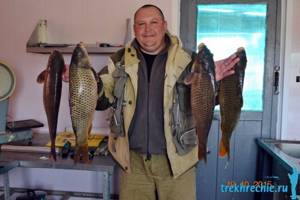
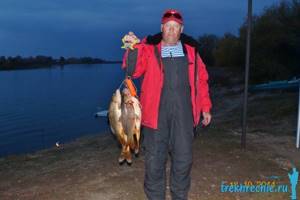
The main line with a diameter of 0.40-0.80 mm is wound on the reel along one side (in a figure of eight). The reel is made of plastic or waterproof plywood. On the other side of the reel, when installing the equipment, a rubber shock absorber, a crossbar with leads and other parts are also placed. The first leash from the sinker is secured approximately one meter from the rubber. The distance between the leashes is approximately 1-1.5 meters - this significantly increases the fishing area and the chance of a bite. The leashes are made short, approximately 8-12 cm, and attached to the line with a twist or special spirals to move the hooks away from the axis of the line while the gear is moving. All connections of the gear elements are made through swivels with carabiners; the ends of the rubber shock absorber are attached to the swivel or steel ring through rings made of durable rubber or soft plastic (to avoid damage to the rubber). (!) The end of the rubber shock absorber is passed into the ring, and the free end of about 6 cm is laid in thirds along the elastic band, slightly stretching it at this moment and each time wrapping it with cotton thread - such a connection will hold well in water when the shock absorber is stretched.
How to communicate with the inspector
In most regions, the float rod and donka are not subject to the ban. The feeder is classified as bottom gear, so fishing with it is allowed. Just don’t forget that one fisherman can fish with only one fishing rod, and the number of hooks cannot be more than two.
However, there are regions where, during the ban, fishing is allowed only with tackle with a float. Here is how it is stated in the regional document of the Tula region: “Forbidden period for the extraction of aquatic biological resources: with all fishing gear, with the exception of float rods from the shore with a total number of hooks of no more than 2 pieces.”
It is important to remember that at this time fishing is allowed only from the coastal zone; the movement of small vessels using engines is strictly prohibited. Who has the right to supervise the implementation of the Rules is only employees of state fisheries protection authorities.
Specialists from various public organizations and even other government agencies, public inspectors do not have any authority to do this. Therefore, if a fisherman has been subjected to some illegal actions on their part, you can safely go to court and appeal.
By the way, the fisherman must have identification documents with him, otherwise he can easily be escorted to the nearest police station to find out his identity, and the path from the shore to him can be quite long.
It is important to remember that all cases are considered administratively, that is, no one has the right to resolve a case on the shore of a reservoir, much less to fine you with a receipt - you are not traveling on a tram. If this happens, file a complaint with the relevant authorities, including the courts.
Donkey sinkers with rubber shock absorber
The weights for the “rubber bands” are selected to be heavy, from 250-400 g, flat and with a rough surface. Installation and removal of the sinker can be done both from the shore and from the boat. When casting a sinker from the shore, there are ways to increase the adhesion of the sinker to the ground without increasing the mass. You can install short nails without heads into the convex part of a spoon-shaped lead sinker so that the ends protrude by 5-10 mm. Such a sinker holds the elastic band well, and the protruding ends of the nails almost do not catch on the grass when pulling the sinker out after fishing. Another option: during casting, pieces of thick soft wire are placed in a cone-shaped sinker so that they resemble the legs of an anchor. Such a sinker also adheres well to the ground, and when caught on an obstacle, the legs easily unbend.
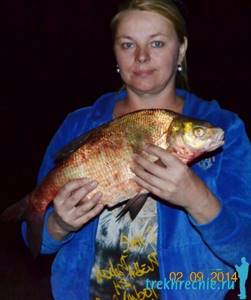
Techniques and features of fishing with a donkey with an elastic band
The main difference between fishing with a donk with an elastic band and conventional gear is the process of its installation. The load is thrown or brought from the boat at the beginning of fishing and removed at the end. The main line is prepared as when installing a regular donkey. A rubber shock absorber is attached to the running end of the main fishing line (without a strap with hooks) using a carabiner fastener, the second end of which is attached through a swivel to a piece of durable cord about 1 meter long. The cord is tied directly to the ring on the sinker. Next, the rubber is laid in a dense snake on a clean, flat surface at the water’s edge, separate from the fishing line. When casting a sinker with the right hand, the angler stands to the right of the elastic band, takes the sinker by the cord and throws it, accelerating it with a pendulum or circular rotation in a vertical plane. The cord is needed to protect the elastic from breaking when thrown.

After casting and eliminating the slack in the fishing line, do not tighten the elastic band for several minutes to allow the sinker to “suck” and stick to the ground. After this, the main fishing line is smoothly taken to the shore, folded in rings behind and away from you, until the end of the shock absorber arrives, which is fixed to the peg with a loop previously made on the main fishing line. Now install the insert-strap with leashes and hooks between the elastic band and the main fishing line (all through carabiners with swivels - the tackle is ready. To make it convenient to work with the hooks alone, follow behind the place where the fishing rod is installed and slightly to the right, pre-install a stake with a hook at a distance from the edge water equal to the length of the line. Thus, you can service the bottom alone, hooking the near end of the line to this stake. Now let go of the line again and adjust the length: the elastic band should completely select the main line, but not pull it. The slight slack of the line from the fishing rod is compensated by the bell ( A bell made from a brass casing from a hunting cartridge is best suited. A correctly configured alarm will respond sensitively to bites, both to jerks from the shore and to pulls to the side and to the shore. Having prepared the tackle in this way, we proceed directly to the fishing process. (!) It is important to remember: - do not hold the tackle taut when working with hooks, always fix the line on the stake behind you; - when releasing the fishing line into the water, always try to keep it as high as possible - this way the hooks are less likely to catch on the algae and the bait will not be torn off by the protrusions of the bottom; - if there is bottom vegetation or reeds in the place where the fishing line is lowered near the shore, take the time to clear the gap for unhindered release of the fishing line with hooks and landing the caught fish; - never lay the fishing line in front of you at the edge of the water - it will definitely get tangled when the hooks move, especially if a fish is caught on the tackle.
Useful tips for fishing with elastic bands
It is advisable to fish with no more than two donks with five hooks on each, unless, of course, such a number of hooks is allowed in a given place by the Fishing Rules. Catch with
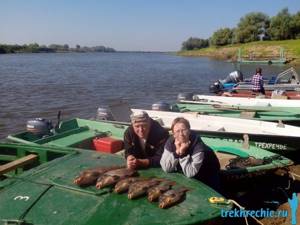
one bottom equipped with ten hooks is less effective: the likelihood of bites is less, it takes a long time to maintain and adjust the bait on such a line, and sitting and watching one bell will probably seem like a dreary task to many, especially if the bite is not like “... on the Black Stones ... " (With). When biting, the hook is made sharp and sweeping - this is necessary due to the long length of the fishing line and its extensibility. With your right hand raised up, describe a semicircle from top to bottom, pick up the main line in front of the fishing rod and continue to jerk back behind you. After this, under no circumstances should you give the line slack; the line must be pulled quickly, but without jerking, to the shore. The prey should be brought to the shore in the water, without lifting it above the surface, and immediately brought into the landing net. A landing net when fishing with an elastic band is necessary, since the stretchable elastic band will not allow the fish to be thrown ashore, and it will not be possible to manipulate the prey due to the low maneuverability of the gear.
Active and passive fishing methods
We selectively quote explanations given by representatives of the Moscow Department of the Federal Fisheries Agency.
Question: Is it possible during the spring ban (from April 1 to June 10) to fish with a spinning rod, feeder, fly fishing, and also use a bombarda (sbirulino) or a summer jig with one hook?
Float rod and feeder
The Fishing Rules do not define a float or bottom fishing rod.
It should be noted that fishing with bottom or float gear using natural baits implies a “passive” method of fishing. In this case, the nozzle is in a calm state or drifts downstream.
The feeder is a bottom fishing rod and fishing with it is not prohibited. The use of a spinning rod for fishing with bottom or float tackle using natural bait (“passive” method) is also not prohibited.
Spinning and others
Spinning, based on encyclopedic definitions (gear for fishing with artificial and natural baits), is an “active” method of fishing, which consists of throwing bait and attracting fish by its play as a result of wiring, pulling and other methods.
Fly fishing without a float, with artificial and natural baits, as well as with a spinning rod, is an “active” method of fishing.
Fishing with a summer jig, as well as with a bombarda (sbirulino), involves attracting fish to play with bait and also refers to “active” fishing methods.
Based on this, fishing with spinning rods, fly fishing, bombards and summer jigs in water bodies of the Moscow region is completely prohibited during the spawning period of fish from April 1 to June 10.
In addition to all this, it is prohibited to have any gear on board a ship or other watercraft, fishing for which is currently prohibited (clause 16.3 of the Fishing Rules).
Thus, any “active” methods of fishing with any bait are prohibited during the spawning ban. Fishing with natural baits can only be done in a “passive” way.
By “active” fishing method we mean attracting fish by playing with bait as a result of any manipulations with tackle and bait.
Bait for rubber band fishing
Considering that fishing with bottom tackle with a rubber shock absorber is a fairly passive process, that is, the angler is not actively looking for fish, but is waiting for it or luring it to the bait, complementary food is required for such fishing. The great advantage of this tackle is that the hooks with the bait return to exactly the same place after each pull. This allows you to feed and
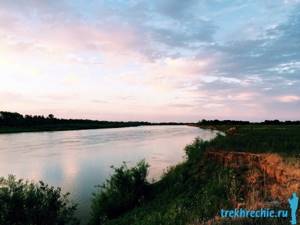
attach fish precisely and very effectively. Bait can be delivered to the fishing point in several ways, using the most convenient for a specific situation and conditions: 1. In the absence of a boat, lumps of bait mixed with soil from the same reservoir are crushed into balls the size of a small apple and hooked onto hooks, then carefully and slowly release the line - the bait at the bottom will get wet in a few minutes and be distributed in the area where the hooks are located. 2. When fishing in the current, bait can be placed in paper bags. The paper will allow the bait to stay on the hook longer and reach the fishing spot safely. 3. You can bring bait from the boat and lower it to the bottom, guided by buoys tied in advance at the beginning and end of the line with hooks - this way the fishing area will be clearly visible. After feeding, the donkey is pulled out and the buoys are removed.
How to fish with a classic donkey
Separately, it is necessary to say about the prohibitions and how many hooks are allowed to have on a donk, because this information will help fishermen save the environment and at the same time do what they love without fear of being fined.
In each region, fish spawn at a certain time, depending on the weather, air and water temperatures. During the spawning period, fishing with multi-hook gear is prohibited and the classic donk and hook cannot be used. But fishing rods with one hook in most regions are allowed for fishing during spawning, however, there are standards for catching fish by one fisherman per day (most often 3–5 kg of fish).
Therefore, when going fishing, you need to find out what the rules are for fishing in the reservoirs you plan to visit and tie the equipment in accordance with the recommendations of the regulatory authorities.
The classic donka and zakidushka, of course, have advantages due to the use of several hooks, but even with one hook in April or May, during the ban, they catch a lot of excellent fish. So if you don't want to take a break from doing what you love, tie donks with one hook and catch as many fish as the law allows.
Variants of donks with elastic for various fishing conditions
In addition to the classic version of the donkey rig with an elastic band, there are many varieties for specific fishing conditions and specific types of fish: catching predators with live bait, catching roach, catching surface fish, for example, chub, sabrefish and asp. So, for catching asp and saber fish, a donkey design is used, the bar with hooks is located at the surface of the water. To do this, a large-capacity float is attached between the elastic band and the hooks, raising the line to the surface, and the fishing depth is adjusted by the length of the leashes. With such a bottom you can successfully catch sabrefish, perch and even asp for fry.
Another version of the donkey device with an elastic band is used in the current. In this case, the bar is pulled down the riverbed by the flow of water and this must be taken into account when installing the gear. Despite all the apparent complexity of a donkey with a rubber shock absorber, properly installed tackle allows you to fish comfortably for a long time and is very easy to use. Try, experiment, introduce your own innovations and improvements and you will have fishing happiness. Welcome to Three Rivers!
More



